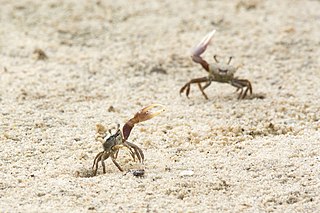
The fiddler crab or calling crab can be one of the hundred species of semiterrestrial marine crabs in the family Ocypodidae. These crabs are well known for their extreme sexual dimorphism, where the male crabs have a major claw significantly larger than their minor claw, whilst females claws are both the same size. The name fiddler crab comes from the appearance of their small and large claw together, looking similar to a fiddle.

The Ocypodidae are a family of semiterrestrial crabs that includes the ghost crabs and fiddler crabs. They are found on tropical and temperate shorelines around the world.

Minuca pugnax, commonly known as the Atlantic marsh fiddler crab, is a species of fiddler crab that lives on north-western shores of the Atlantic Ocean.

Austruca mjoebergi is a species of fiddler crab discovered by and named after the Swedish zoologist Eric Mjöberg (1882–1938), member of a Swedish scientific expedition to Australia in the early 1900s.

Afruca tangeri is a species of fiddler crab that lives along the Atlantic coasts of western Africa and southwestern Europe.

Paraleptuca crassipes or the thick-legged fiddler crab is a species of fiddler crab that lives in intertidal habitats distributed across the western Pacific Ocean.

Tubuca urvillei is a species of fiddler crab. It is found in Southeastern Africa from southern Somalia to South Africa and Madagascar.

Tubuca alcocki is a species of fiddler crab. Its range includes most of the northern Indian Ocean, from western Thailand, through the Bay of Bengal and India, to the Red Sea.

Leptuca panacea, commonly known as the Gulf sand fiddler crab or the Panacea sand fiddler, is a species of fiddler crab native to coastal habitats along the Gulf of Mexico from northwestern Florida to Mexico.
Leptuca speciosa, commonly known as the brilliant fiddler crab or the longfinger fiddler crab, is a species of fiddler crab native to the southern United States, Mexico, and the Caribbean.
Leptuca cumulanta, commonly known as the heaping fiddler crab or the mangrove fiddler crab, is a species of fiddler crab native to tropical and subtropical areas of the western Atlantic.

Leptuca uruguayensis, commonly known as the Uruguayan fiddler crab or the southwestern Atlantic fiddler crab, is a species of fiddler crab native to temperate and subtropical areas of the southeastern coast of South America.
Leptuca beebei, commonly known as Beebe's fiddler crab, is a species of fiddler crab native to the Pacific coasts of Central and South America, from El Salvador to northern Peru.
Leptuca batuenta, commonly known as the beating fiddler crab, is a species of fiddler crab native to the tropical eastern Pacific, from El Salvador to northern Peru.
Leptuca deichmanni, commonly known as Deichmann's fiddler crab, is a species of fiddler crab native to the eastern Pacific coast of Central America, in Costa Rica and Panama.
Leptuca musica, commonly known as the musical fiddler crab, is a species of fiddler crab native to Baja California and the Gulf of California in Mexico.
Leptuca terpsichores, commonly known as the dancing fiddler crab, is a species of fiddler crab native to the eastern Pacific coast of the Americas, from Nicaragua to Peru.

Tubuca polita, commonly known as the polished fiddler crab. or pink-clawed fiddler crab is a species of fiddler crab that is found in the northern part of Australia including the Torres Strait Islands

Tubuca coarctata is a species of fiddler crab found in the western Pacific ocean, including Japan, Taiwan, the Philippines, Indonesia, New Guinea and Australia. The common name of these crabs is either the compressed fiddler crab, or the orange-clawed fiddler crab,. They are found on tidal mud flats adjacent mangroves and muddy tidal creek and river banks.

Tubuca dussumieri, is a species of fiddler crab that is found in the western and south pacific including New Caledonia, Indonesia, Malaysia, Taiwan, Japan, north eastern Australia












